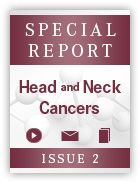Thyroid Cancer Increase in Pennsylvania Provides Clues to Underlying National Surge
The incidence of thyroid cancer in Pennsylvania has grown at a rate significantly higher than that observed in the rest of the country.
The incidence of thyroid cancer in Pennsylvania has grown at a rate significantly higher than that observed in the rest of the country. Tumor size and stage at diagnosis are also increasing at an abnormal rate in this geographic region.
Darrin V. Bann, PhD, and colleagues from the Penn State College of Medicine and the Penn State Milton S. Hershey Medical Center in Pennsylvania, reported their findings in the August 28, 2014 issue ofJAMA Otolaryngology Head and Neck Surgery.1
“Thyroid cancer is now the seventh leading type of cancer in the nation,” said senior author, David Goldenberg, MD. “It typically occurs in young women and is projected to become the third most common cancer in women by 2019.”2
While surgery results in a 10-year survival rate of 95%, the disease still presents significant morbidity, as well as clinical and economic burdens.
A study analyzing data from the Surveillance, Epidemiology, and End Results 9 (SEER-9) registry showed that the national incidence of thyroid cancer nearly tripled from 1975 to 2009, with women experiencing a growth rate 4 times higher than men.3
Many believe this trend is a mere artifact of better diagnostic tools, observed primarily in small papillary carcinomas (≤2 cm). Others in the field, however, argue it is due to a true increase in disease.
“Increasing trends for larger tumors rules out diagnostic scrutiny as the only explanation,” wrote Lucas B. Vergamini and colleagues in their recent publication reporting increased incidence specifically in children, adolescents, and young adults.4
Marcia S. Brose, MD, PhD, on the Sequencing Sorafenib and Lenvatinib
Brose is from the Abramson Cancer Center
In the current study, the authors identified 110,615 SEER-9 records and 29,030 from the Pennsylvania Cancer Registry (PCR), spanning from 1985 to 2009.
Investigators compared the average annual percent change (AAPC) in thyroid cancer incidence between Pennsylvania and the remainder of the United States. Data were reviewed for information regarding stage and histologic type of thyroid cancer, tumor size at diagnosis, as well as demographics such as sex and race.
Overall, Pennsylvania experienced an AAPC of 7.1% per year compared with only 4.2% per year in the rest of the country (P<.001). Concurrent with other reports, incidence rate in females was significantly higher compared with men (7.6% vs 6.1% per year, respectively;P<.01). The fastest rate of change was observed in black females.
Increased incidence was apparent not only in local tumors, but also in those with regional and distant metastasis, and those from 2 to 4 cm and >4 cm at diagnosis.
“These data suggest that an overdiagnosis model…is not sufficient to explain the rise in thyroid cancer incidence in Pennsylvania,” the authors wrote. Instead, the findings “imply that local environmental factors may play a role in the incidence of thyroid cancer.”1
Potential risk factors may include obesity, aberrant iodine levels, radiation exposure, hormones, or diet. Increased use of imaging technology may also contribute to heightened detection of larger tumors.
“Etiologic factors underlying the national increase in thyroid cancer may be concentrated in Pennsylvania,” Bann and colleagues noted, emphasizing the need for investigation of environmental, dietary, and genetic influences that may be contributing to this unexpected trend.1
References:
- Bann DV, Goyal N, Camacho F, et al. Increasing incidence of thyroid cancer in the Commonwealth of Pennsylvania [published online ahead of print August 28, 2014].JAMA Otolaryngol Head Neck Surg. 2014. doi: 10.1001/jamaoto.2014.1709.
- Penn State News. Thyroid cancer rates in Pennsylvania rising faster than rest of country.http://news.psu.edu/story/325718/2014/09/10/research/thyroid-cancer-rates-pennsylvania-rising-faster-rest-country. Accessed September 24, 2014.
- Davies L and Welch HG. Current thyroid cancer trends in the United States.JAMA Otolaryngol Head Neck Surg. 2014;140(4):317-322.
- Vergamini LB, Frazier AL, Abrantes FL, et al. Increase in the incidence of differentiated thyroid carcinoma in children, adolescents, and young adults: a population-based study.J Pediatr. 2014;164(6):1481-1485.
Clinical Pearls
- Incidence of thyroid cancer in Pennsylvania has grown at a rate significantly higher than in the rest of the country.
- Study analyzing data from the SEER-9 registry showed that the national incidence of thyroid cancer nearly tripled from 1975 to 2009.
- Pennsylvania experienced an AAPC of 7.1% per year compared with 4.2% per year in the rest of the country.
- Data suggest overdiagnosis model does not explain rise in thyroid cancer incidence in Pennsylvania and imply that local environmental factors may play a role.
- Researchers stressed need for investigation of environmental, dietary, and genetic influences that may be contributing to this unexpected trend.

Anticipating Novel Options for the RAI-Refractory DTC Armamentarium
May 15th 2023In season 4, episode 6 of Targeted Talks, Warren Swegal, MD, takes a multidisciplinary look at the RAI-refractory differentiated thyroid cancer treatment landscape, including the research behind 2 promising systemic therapy options.
Listen